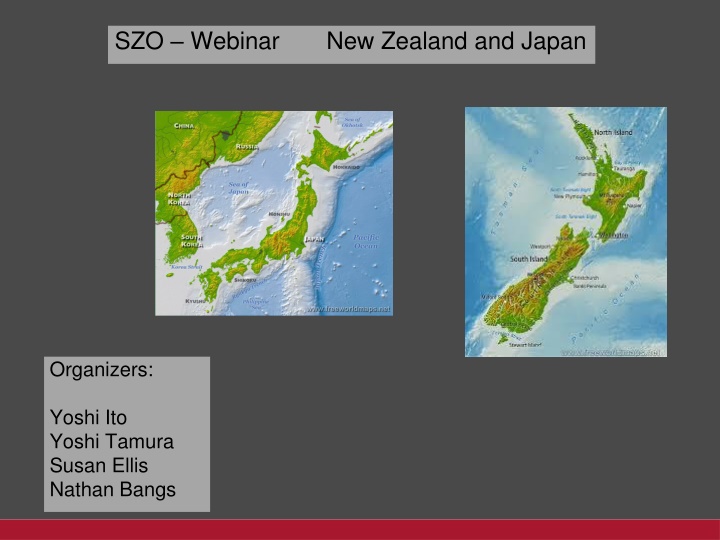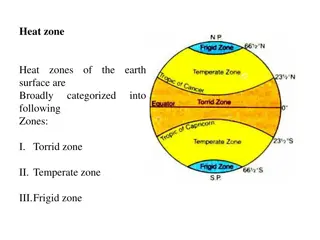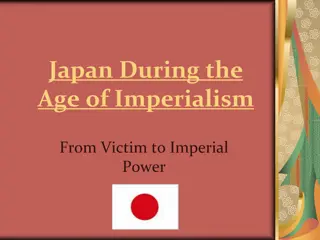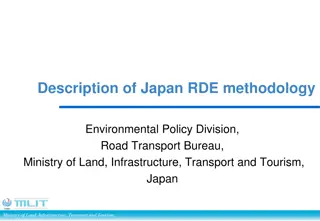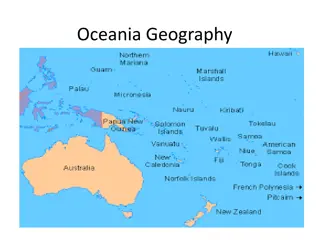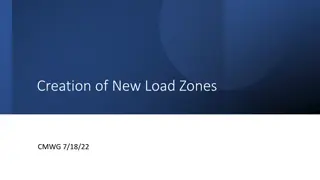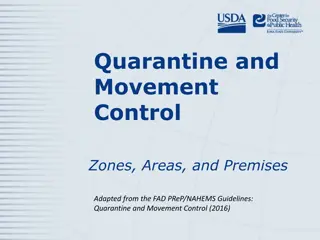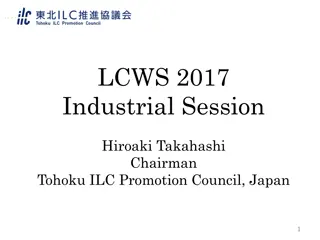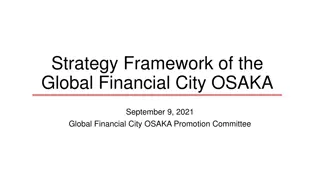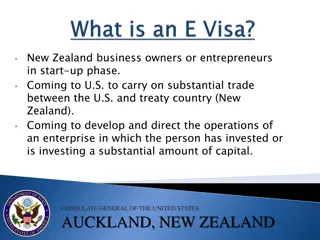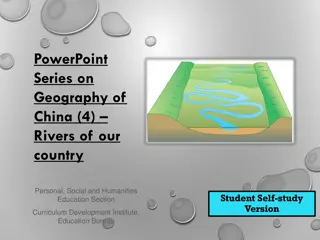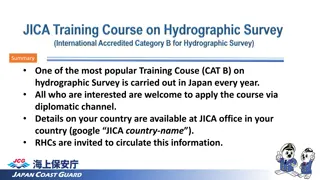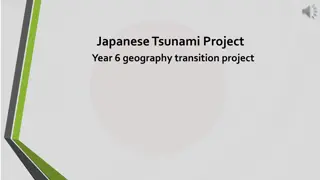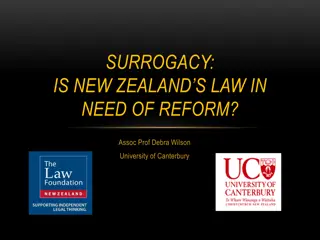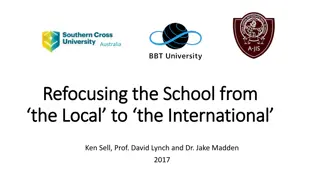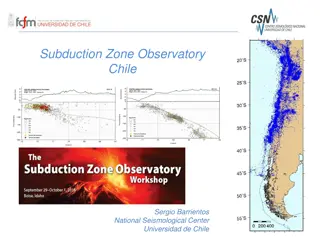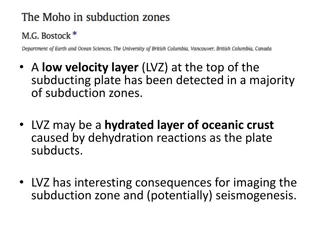Exploration of Subduction Zones in New Zealand and Japan
Delve into the fascinating world of subduction zones in New Zealand and Japan, led by a team of expert organizers. Discover the unique tectonic features, key opportunities for research, and pivotal scientific questions surrounding these geological marvels. Uncover insights on subduction dynamics, seismic activity, and potential rupture dimensions to deepen your understanding of these complex natural phenomena.
Download Presentation

Please find below an Image/Link to download the presentation.
The content on the website is provided AS IS for your information and personal use only. It may not be sold, licensed, or shared on other websites without obtaining consent from the author.If you encounter any issues during the download, it is possible that the publisher has removed the file from their server.
You are allowed to download the files provided on this website for personal or commercial use, subject to the condition that they are used lawfully. All files are the property of their respective owners.
The content on the website is provided AS IS for your information and personal use only. It may not be sold, licensed, or shared on other websites without obtaining consent from the author.
E N D
Presentation Transcript
SZO Webinar New Zealand and Japan Organizers: Yoshi Ito Yoshi Tamura Susan Ellis Nathan Bangs
OVERVIEW OF NEW ZEALAND SUBDUCTION NEW ZEALAND TECTONICS Hikurangi subduction - - T aupo Volcanic Zone and rift [most productive rhyolitic system on earth; magma-tectonic interactions] - Puysegur subduction zone and Fiordland [juvenile subduction zone, caught in the act of initiation; root zone of an ancient arc] - Havre trough and Kermadec arc [undersea silicic magmatism; volatile fluxes in back- arc setting; along-striie changes in sediment input] Bathymetry from NIWA See also a summary of relevant literature https://www.iris.edu/hq/works hops/2016/09/szo_16 1. Tectonic overview GNS Science
Key Opportunity: Locking on interface and its relationship to slow slip along the Hikurangi Margin Wallace et al. 2004 (JGR) Douglas et al., 2005 (GRL) Wallace and Beavan, 2010 (JGR) Wallace et al., 2012 (JGR) Bartlow et al., 2014 (JGR) Wallace et al., 2016 (Science) 2. Strain accumulation on subduction interface GNS Science
Key Opportunity: Along-strike margin transitions Southern segment (Wairarapa) Central segment (Hawke's Bay) Northern segment (Raukumara) INCREASING SEDIMENT THICKNESS DECREASING SUBDUCTION FLUID COMPONENT TECTONIC EROSION BACKARC EXTENSION STEEP WEDGE geophysical evidence for high fluid content within upper plate FRONTALACCRETION CONTRACTION SHALLOW WEDGE Figure 1: Oblique view of North Island with depth contours of subducting Pacific Plate (blue dashed lines), convergence rates at the Hikurangi Trench (red arrows), and locked (red) vs. slipping interface. Black dashed line marks approximate location of the change from locked to slipping behaviour.
Key Opportunity: Examine seamount subduction, highly reflective zones, wedge structure, and the developments along the plate interface Barker et al., 2009; Bell et al., 2010; IODP proposal 781A Ghisetti et al., 2016; Plaza-Faverola et al., 2016 MBIE proposal 2016 4. Transitions along-strike GNS Science
Key science questions- Hikurangi 1.Why is there a transition in locking depth from shallow in north to deep in south? Fluids pressures? Composition of interface? Roughness of interface? Composition of upper plate? Other reasons? 2.What is the maximum rupture dimension for a Hikurangi megathrust earthquake? North and south rupture together? How deep/shallow? Role of splay faults?T sunamogenic potential? 3.What causes SSEs and do they trigger LFEs, tremor, micro or macroseismicity (and vice-versa)? 7. Questions for discussion GNS Science
FUNDED PROJECTS (International Collaborations) - SHALLOW SLOW SLIP PART 1: IODP riserless drilling proposal 781A and APL: - Expedition 375 - sample sediment input section, downhole logs, install observatories [main cruise scheduled March-May 2018] - Expedition 372 LWD [scheduled ~ Dec 2017] 3D seismic investigation of faults around 781Adrilling transect: US (NSF), UK, Japan, NZ; Jan/Feb 2018 [Bangs et al., Bell, Kodaira, Henrys, Mochizuki] 6. Ongoing projects GNS Science
FUNDED PROJECTS - SHALLOW SLOW SLIP PART 2: MBIE contestable research fund- $6.5M NZD (NZ research time, paleoseismology, modeling, rolling seafloor geodesy, science in support of drilling and active source surveys: NZ, Japan, US) [PI Wallace, Henrys] HOBITSS (NSF)- APG data published (Wallace et al., 2016), seismological data (OBS) in progress- [PI Schwartz, Sheehan] Fry- tremor locations, mechanisms MBIE proposal- onshore/offshore sampling 6. Ongoing projects HOBITSS OBS data- Erin T odd- (WIP) GNS Science
FUNDED PROJECTS- MEGATHRUST BEHAVIOR variations along-strike MBIE fund (see last page)- paleoseismological part will analyse offshore (turbidites) [Barnes et al.] and onshore (paleoseismic record) [Cochran, Clark] SHIRE: integrated earth systems NSF project. Active source transects (McIntosh, vanAvendonk, Okaya) across and along-strike. Paleoseismology onshore (Marshall, Pilarczyk). Numerical modeling (fluid-mechanical interactions, sediment underplating- 2D and 3D) (Saffer) Land-based MT : GNS group [Opportunities for offshore MT] NSF: time dependent inversions for slow-slip for Hikurangi and revise locking models [PIs Bartlow, Wallace]; Heatflow [PI Harris] Marsden (NZ)- [PI Kaneko] Probing the Hikurangi subduction mega-thrust using full-waveform inversion GNS MT group data points SHIRE IES proposal 6. Ongoing projects GNS Science
There are many potential New Zealand partners GeoNet New Zealand Earthquake Commission Ministry of Business, Innovation and Employment Royal Society of New Zealand GNS Science NIWA Victoria University of Wellington U. OfAuckland Waikato University University of Canterbury Otago University East Coast LAB (Life at the Boundary)- funded by NZ government and regional councils GNS Science
Japan Subduction Overview ADer The headquarters for Earthquake Research Promo/on hIp://jishin.go.jp
Key Opportunity Nankai Trough: Mechanical and hydrologic properties of faults within the shallow forearc of a sediment-rich, accretionary margin Recent & Ongoing Project: Nankai Trough IODP Nanaki drilling KANAME(FY2009-2013)[PI:Gaku Kimura] Understanding overall framework of the Nankai Trough subducion zone Revealing materials, and mechanical and hydrologic properties of seismogenic faults Construction and verification of a comprehensive model for pre-and co-seismic processes KAKEN-S(FY2015-2019)[PI: Gaku Kimura] hIp://www-solid.eps.s.u- tokyo.ac.jp/nantro~en/gaiyo.html
Key Opportunity Nankai Trough: Slow earthquakes Recent & Ongoing Project: Slow Earthquakes Science of Slow earthquakes(FY2016-2020)[PI: Kazushige Obara] From Discovery to Understanding From regional to general understanding
Key Opportunity Japan Trench: Shallow slip and its relation to the megathrust Recent & Ongoing Project: Japan Trench History of Shallow Megathrust events JDASH(FY2014-2018)[PI: Ryota Hino] Revealing past shallow seismic slip and deformation from high-resolution seismic survey Investigating past megathrust events from tsunami turbidite layers based on core samples from ultra-deep piston coring near the Japan trench Identify postseismic deformation processes on the shallow fault by using dense arrays of broadband seismic and geodetic sensors Mapping potential faults of outer-rise earthquakes KAKEN-S(FY2015-2019)[PI: ShuichiKodaira] Kodaira et al. 2012 Sun et al., 2014
Key Opportunity: Co-existance of fast and slow rupture on the megathrust Scientific Questions & New Opportunities What controls on fast and slow rupture mode, especially shallow portion ? Why both fast and slow ruptures co-exist ? What controls the migration speeds, or rupture speeds ? Periodic SSE Coexsistence with fast and slow ruptures Variation of migration speeds, or rupture from SSE to megathrust Kato et al.., 2013 Uchida et al.., 2016 Ito et al.., 2013
Partners & International Collaborations JAMSTEC NIED AIST JCG JMA GSI Japanese Universities
C Cr rust ust- -Mantle Mantle Connections Connections F Fr ro om m Iz Izu u- -O Oga (Bonin (Bonin) ) an and d Aleutia A Ar rcs cs t to o K Ke er rmade gas sa aw Aleutian n madec c A Ar rc c wa ar ra a Y Yos osh hi ih hi ik ko o T Ta am Fu Fuji jiw wa ar ra a Shui ( (J JAMSTEC) AMSTEC) mu ur ra a, , T Ta ak ke es sh hi i S Sa at to o, , T To os sh hi iy ya a Shuic ch hi i K Kodai odair ra a & & Al Ale exande xander r Ni Nic chol hols s
Seismic velocity image along the volcanic front of the Izu- Ogasawara arcs obtained by seismic refraction tomography (Kodaira et al., 2007).
Rising mantle diapirs stall near the base of the oceanic crust at depths controlled by the thickness of the overlying crust. Where the crust is thin, melting occurs at relatively low pressures in the mantle wedge producing andesitic magmas. Where the crust is thick, melting pressures are higher and only basaltic magmas tend to be produced.
Key Opportunity: Examine relationship between island arc composition and crustal thickness Seismic velocity image along the volcanic front of the Izu- Ogasawara arcs obtained by seismic refraction tomography (Kodaira et al., 2007).
FUNDED PROJECTS- FLUIDS/MECHANICS NSF: [PI Jaime Barnes] Fluid-mobile and volatile element (Cl, B, and Li) cycling through the forearc (+Waikato): Shaun Barker -detecting fluid changes associated with SSEs, N Hikurangi Sticky/Creepy Marsden [PI Ellis], will be continued under IES/MBIE: fluid chemistry and flowrates; fluid flow, modeling Agnes Reyes, in prep. Ellis et al., 2015 6. Ongoing projects GNS Science
Seismic tomography Interface contours in depth Onshore MT Williams et al., 2013 Heise et al., 2013 NORTH Eberhart- Phillips et al., 2010, 2013; 2015 VpVs on interface SOUTH - T omography: high Vp/Vs along interface in north MT : electrically conductive interface in north - 4. Transitions along-strike GNS Science
Scientific Quetions & New Opportunties What is next infrastructures and facilities to observe various phenomena on the plate interface ? How do we evaluate real-time monitoring data to mitigate earthquake and tsunami disasters ? GPS/A: Japan Coast Guard
